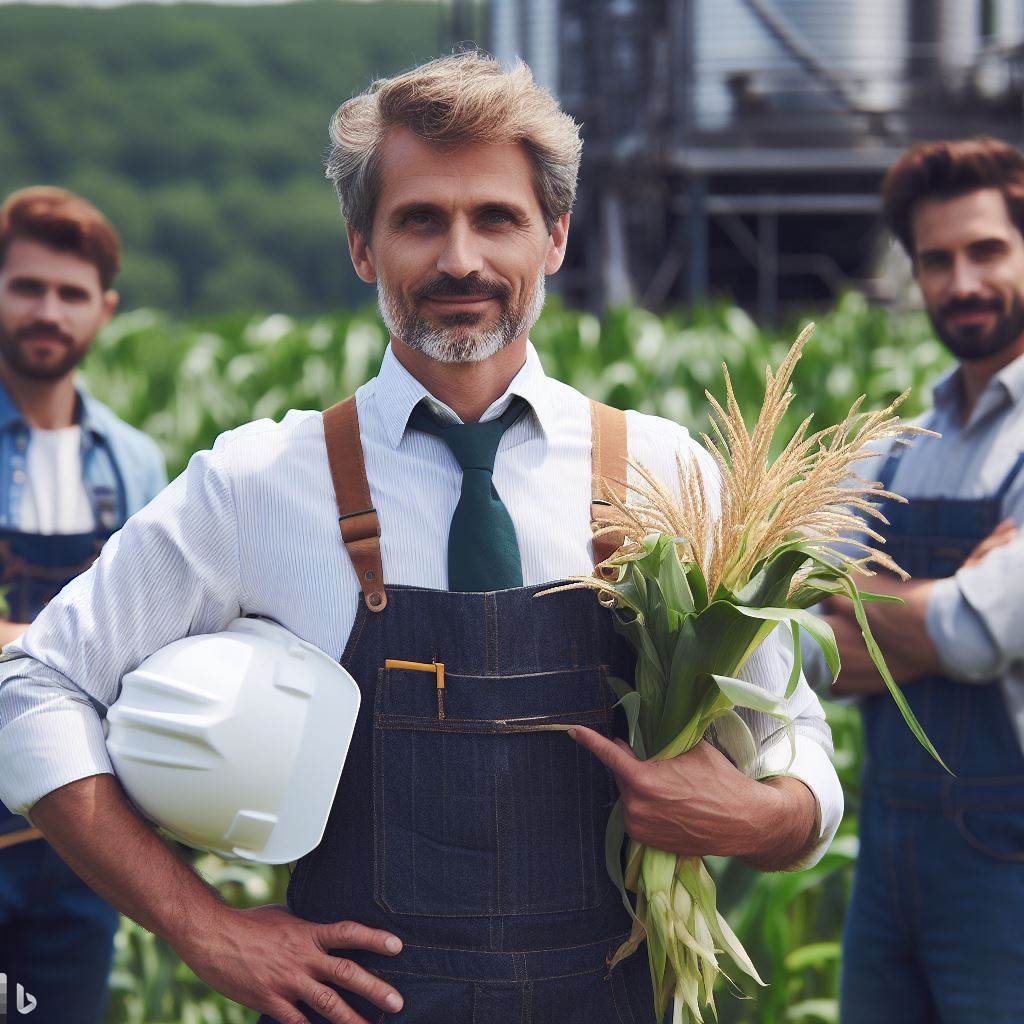Introduction
In this article we will discuss Farm Safety Standards Ag Engineer Responsibility.
Farm safety stands as a paramount concern in the United States, not just for the well-being of agricultural workers but also for the preservation and growth of the agricultural industry.
Agricultural engineers hold a significant role in the realm of farm safety.
They are tasked with the responsibility of designing, implementing, and continuously improving safety standards and practices in farming.
This blog post aims to shed light on the pivotal importance of farm safety within the agricultural sector.
Furthermore, it seeks to emphasize the indispensable role that agricultural engineers play in ensuring and enhancing safety on farms across the nation.
Farm safety isn’t just a requirement; it’s a fundamental aspect that underpins the sustainability, productivity, and prosperity of the American agricultural landscape.
In the sections to follow, we will explore the multifaceted dimensions of farm safety and delve deeper into the engineer’s responsibility in upholding these crucial standards.
Overview of US Farm Safety Standards
Farm safety standards
- Farm safety standards are guidelines and regulations implemented to ensure the well-being of workers and protect them from hazards.
- These standards cover a wide range of areas such as machinery operation, chemical handling, livestock handling, and electrical safety.
Government agencies responsible for setting and enforcing these standards
- The Occupational Safety and Health Administration (OSHA) is the primary federal agency responsible for regulating and enforcing farm safety standards.
- The National Institute for Occupational Safety and Health (NIOSH) conducts research, provides recommendations, and collaborates with OSHA to enhance farm safety practices.
- State departments of agriculture also play a crucial role in promoting and enforcing safety standards within their respective jurisdictions.
The importance of adherence to safety standards in preventing accidents and injuries on farms
- Adherence to safety standards is essential because agricultural work can be dangerous and is associated with a higher risk of accidents and injuries.
- Following safety regulations reduces the likelihood of workplace incidents, including equipment malfunctions, falls, chemical exposures, and animal-related accidents.
- Compliance with safety standards helps protect workers’ health, minimizes financial losses due to accidents, and ensures a sustainable future for the farming industry.
List of Key Farm Safety Standards
1. Machinery Safety
- Regular maintenance, training on safe operation, and proper guarding are essential to prevent machinery-related accidents.
- Safety features such as Rollover Protective Structures (ROPS) and seat belts must be used on tractors.
- Lockout and tagout procedures should be implemented to safeguard against unexpected machinery movements during maintenance.
2. Chemical Handling
- Proper storage, labeling, and handling of chemicals reduce the risk of exposure and accidents.
- Personal protective equipment (PPE) like gloves, goggles, and respiratory protection should be used when handling hazardous substances.
- Employers should provide training on safe chemical handling practices, emergency procedures, and the use of safety data sheets (SDS).
3. Livestock Handling
- Training in proper animal handling techniques is crucial to prevent injuries caused by bites, kicks, or trampling.
- Adequate facilities and equipment, such as chutes, gates, and non-slip flooring, should be in place to ensure safe livestock handling.
- Understanding animal behavior and employing appropriate restraint methods contribute to reducing accidents in livestock handling operations.
5. Electrical Safety
- Regular inspection and maintenance of electrical systems are necessary to prevent electrical shock, fires, and equipment damage.
- Wiring should be properly installed, grounded, and protected from moisture and physical damage.
- Workers must receive training on electrical hazards, lockout/tagout procedures, and the use of ground fault circuit interrupters (GFCIs).
Basically, understanding and adhering to US farm safety standards is an essential responsibility for agricultural engineers.
Government agencies like OSHA and NIOSH set and enforce safety standards, covering machinery operation, chemical and livestock handling, and electrical safety..
By following these standards, farmers can prevent accidents and injuries, protect their workers, and ensure the long-term sustainability of the farming industry.
Responsibilities of an Ag Engineer in Farm Safety
Agricultural Engineers play a crucial role in ensuring farm safety through various responsibilities. These include:
Conducting safety inspections on farm equipment and machinery
Ag Engineers have the responsibility to regularly inspect farm equipment and machinery to identify and address potential safety hazards.
These inspections involve checking for faulty parts, ensuring proper maintenance, and assessing the overall safety of the equipment.
Diligent inspections not only prevent accidents and injuries but also contribute to the overall efficiency and productivity of the farm operations.
By identifying and addressing equipment issues proactively, Ag Engineers help farmers minimize downtime and optimize their resources.
Designing and implementing safety mechanisms for farm operations
Another important responsibility of Ag Engineers is to design and implement safety mechanisms that enhance the overall safety of farm operations.
This includes developing safety features for machinery, implementing ergonomic designs, and creating safety protocols for various farm processes.
Ag Engineers need to stay updated with the latest advancements in technology and safety standards to ensure that their designs effectively mitigate risks and protect farm workers.
By incorporating safety measures into the equipment and operations, they help create a safer work environment for all involved.
Training farmers and farm workers on safety protocols and best practices
Ag Engineers play a vital role in training farmers and farm workers on safety protocols and best practices.
They provide necessary guidance and education on topics such as equipment operation, handling hazardous substances, and emergency response procedures.
By conducting comprehensive training programs, Ag Engineers ensure that farm workers are equipped with the knowledge and skills to navigate potential risks confidently.
Effective training also promotes a culture of safety on the farm, improving overall awareness and reducing the likelihood of accidents.
Collaborating with other professionals to address safety concerns and develop solutions
Ag Engineers do not work in isolation but actively collaborate with other professionals to address safety concerns and develop innovative solutions.
They partner with agronomists, environmental scientists, and health experts to design integrated safety strategies.
Through collective efforts, Ag Engineers bring together their expertise to tackle complex safety challenges, such as chemical exposure prevention, ergonomic design implementation, and biosecurity measures.
This interdisciplinary approach ensures comprehensive safety standards and fosters continuous improvement in farm safety practices.
Generally, Ag Engineers shoulder significant responsibilities in farm safety.
Their paramount contributions encompass conducting inspections, implementing safety mechanisms, providing training, and collaborating with fellow professionals to ensure farm safety.
Read: Ethical Practices for Animal Breeders: US Standards
The Importance of Risk Assessment and Management
- Conducting risk assessments to identify potential hazards on farms
- Developing risk management strategies to minimize the occurrence and impact of accidents
- Regularly reviewing and updating risk assessment plans to adapt to changing circumstances
In the field of agriculture, safety should always be a top priority. Farmers and agricultural engineers play a crucial role in ensuring the well-being of farm workers and reducing the occurrence of accidents.
One of the key responsibilities of an agricultural engineer is to conduct risk assessments to identify potential hazards on farms.
Conducting risk assessments to identify potential hazards on farms
Risk assessments are a proactive approach to evaluate the possible dangers associated with farming activities.
By identifying and understanding potential risks, preventive measures can be put in place to minimize accidents and injuries.
This involves a systematic process of identifying hazards, assessing their potential impact, and determining appropriate control measures.
During the risk assessment process, agricultural engineers must carefully examine each aspect of farm operations.
They need to consider factors such as machinery, equipment, working conditions, and environmental factors that may pose a threat to the safety and well-being of farm workers.
By conducting thorough risk assessments, potential dangers can be identified early on, allowing for the implementation of effective risk management strategies.
Developing risk management strategies to minimize the occurrence and impact of accidents
Once potential hazards are identified, the next step is to develop risk management strategies.
These strategies aim to minimize the occurrence and impact of accidents by implementing control measures and safety protocols.
Agricultural engineers work closely with farmers and farm workers to develop and implement these strategies.
Transform Your Career Today
Unlock a personalized career strategy that drives real results. Get tailored advice and a roadmap designed just for you.
Start NowImplementing risk management strategies involves a combination of engineering controls, administrative controls, and personal protective equipment.
Engineering controls include designing and modifying equipment to reduce risks, such as installing safety guards on machinery or improving ventilation systems in enclosed spaces.
Administrative controls involve establishing policies and procedures to ensure safe work practices, such as providing training on equipment operation or enforcing safety protocols.
Personal protective equipment, such as goggles, gloves, and protective clothing, is used as a last line of defense to protect workers from potential hazards.
Regularly reviewing and updating risk assessment plans to adapt to changing circumstances
It is crucial for agricultural engineers to regularly review and update risk assessment plans to adapt to changing circumstances. Farm Safety Standards Ag Engineer Responsibility
Farming operations may evolve over time, with new machinery, technologies, or environmental factors affecting the safety of farm workers.
By continuously reviewing and updating risk assessments, agricultural engineers can ensure that safety protocols and control measures are up to date and effective in preventing accidents and injuries.
In review, risk assessment and management are essential components of ensuring farm safety.
Agricultural engineers play a critical role in this process by conducting risk assessments, developing risk management strategies, and regularly updating these plans.
By proactively identifying and mitigating potential hazards, farm workers can work in a safer environment, reducing the risk of accidents and injuries.
Read: Challenges Faced by Modern US Animal Breeders

Discover More: US Farmer’s Battle Against Climate Change & Weather
Innovations and Technologies in Farm Safety
Introduction to various technological advancements in farm safety
- Technological advancements play a crucial role in improving farm safety standards.
- These innovations are designed to minimize risks and hazards faced by agricultural workers.
- They leverage advanced machinery, automation, and data analysis to enhance overall farm safety.
Examples of innovative tools and equipment designed for farm safety
- Wearable technology: Smart wearables like GPS trackers, monitors, and sensors can track worker location and vital signs.
- Automated machinery: Robots and drones can perform tasks, reducing human exposure to dangerous environments.
- Safety alarms and sensors: These devices detect hazardous conditions such as gas leaks or equipment malfunctions.
- Data analytics: Advanced software can analyze data from sensors and predict potential safety hazards.
Benefits of integrating these innovations in farm operations
- Enhanced worker safety: The integration of these technologies reduces human involvement in risky tasks.
- Improved efficiency: Automated machinery and data analytics optimize farm operations, reducing accidents and injuries.
- Real-time monitoring: Wearables and sensors provide real-time data on worker location, health, and hazardous conditions.
- Early detection of risks: Advanced sensors and analytics can identify potential hazards before they become critical issues.
- Cost savings: Implementing these technologies initially incurs expenses but can lead to long-term cost savings through improved safety and efficiency.
- Compliance with regulations: Farm safety innovations help farms meet regulatory standards and avoid penalties.
Innovations and technologies in farm safety have the potential to revolutionize agricultural practices.
By integrating these advancements, farmers can ensure the well-being of their workers while optimizing their operations. Farm Safety Standards Ag Engineer Responsibility
Technologies such as wearables, automated machinery, and data analytics contribute to enhanced safety standards, improved efficiency, and compliance with regulations.
As an agricultural engineer, it is essential to stay updated with these innovations and advocate for their implementation in farm operations.
Read: US Breeding Regulations: What New Breeders Must Know
Challenges in Implementing Farm Safety Standards
In order to effectively implement farm safety standards, agricultural engineers face several challenges:
Resistance from farmers due to cost and time implications
- Farmers may resist implementing safety standards due to the perceived financial burden.
- Many farmers operate on tight budgets and may not have extra funds to invest in safety measures.
- Implementing safety standards often requires additional time and labor, which can be seen as a hindrance to productivity.
Lack of awareness or knowledge about farm safety practices
- Some farmers may not be aware of the potential dangers and risks associated with their daily operations.
- A lack of knowledge regarding safety practices can lead to accidents and injuries on the farm.
- Agricultural engineers must educate farmers about the importance and benefits of farm safety.
Overcoming cultural norms or attitudes towards safety
- In certain farming communities, there may be a prevailing attitude that prioritizes productivity over safety.
- Changing deeply ingrained cultural norms surrounding safety can be a significant challenge.
- Agricultural engineers must work to shift these attitudes and emphasize the importance of safety in farming.
Overcoming these challenges requires a multifaceted approach:
1. Education and Awareness
Agricultural engineers must proactively educate farmers about the potential hazards on their farms and the benefits of implementing safety measures.
They should organize workshops, training sessions, and awareness campaigns to disseminate information and resources to farmers.
2. Research and Development
Agricultural engineers should continue to develop innovative technologies and practices that enhance farm safety without compromising productivity.
Investing in research and development ensures that farmers have access to cost-effective and efficient safety solutions.
3. Collaboration and Partnerships
Agricultural engineers can collaborate with government agencies, agricultural organizations, and industry leaders to implement farm safety standards.
By working together, they can pool resources, share expertise, and collectively address the challenges associated with implementing safety measures.
4. Incentives and Support
Providing farmers with incentives, such as grants or tax breaks, can help alleviate the financial burden of implementing safety standards.
Additionally, agricultural engineers can offer ongoing support and guidance to farmers to ensure effective implementation and maintenance of safety practices.
To sum it up, implementing farm safety standards presents challenges that agricultural engineers need to address.
By focusing on education, research, collaboration, and support, they can overcome resistance, improve awareness, and foster a culture of safety in the farming community.
Read: Financial Prospects of Animal Breeding in the USA
Conclusion
It is crucial for agricultural engineers to play a key role in promoting farm safety standards. Throughout this blog section, we have highlighted their responsibilities and challenges.
However, it is important to emphasize the need for increased focus on farm safety awareness and implementation.
Transform Your Career Today
Unlock a personalized career strategy that drives real results. Get tailored advice and a roadmap designed just for you.
Start NowAgricultural engineers have a significant responsibility in ensuring the safety and well-being of farmers and workers.
By designing and implementing safety measures, they can prevent accidents and reduce the risk of injuries on farms.
Throughout this section, we have discussed the responsibilities agricultural engineers have in promoting farm safety standards.
They must analyze farm operations, identify potential hazards, and develop strategies to mitigate risks.
Additionally, they need to stay updated with the latest safety regulations and technologies to effectively improve farm safety standards.
However, challenges lie ahead for agricultural engineers. Farm Safety Standards Ag Engineer Responsibility
Limited resources, resistance to change, and the complexity of implementing safety protocols pose obstacles in their mission to make farms safer.
Overcoming these challenges requires collaboration with farmers, industry stakeholders, and policymakers to develop effective solutions.
To summarize, there is a pressing need for increased focus on farm safety awareness and implementation.
Agricultural engineers should actively participate in raising awareness about the importance of farm safety through workshops, training programs, and educational campaigns.
Collaboration with farmers and industry stakeholders is also crucial in implementing safety protocols effectively.
Let us all take action and work together towards improved farm safety standards. Farm Safety Standards Ag Engineer Responsibility
By emphasizing the significance of implementing safety measures, we can protect the lives and well-being of those working in the agriculture industry.
Together, we can create a safer and more secure environment for everyone involved in farming.
[E-Books for Sale]
The Big Book of 500 High-Paying Jobs in America: Unlock Your Earning Potential
$19.99 • 500 High-Paying Jobs • 330 pages
Explore 500 high-paying jobs in America and learn how to boost your career, earn more, and achieve success!
See All 500 High-Paying Jobs of this E-Book
1001 Professions Without a Degree: High-Paying American Jobs You Can Start Now
$19.99 • 1001 Professions Without a Degree • 174 pages
Discover 1001 high-paying jobs without a degree! Unlock career tips, skills, and success strategies for just $19.99!




